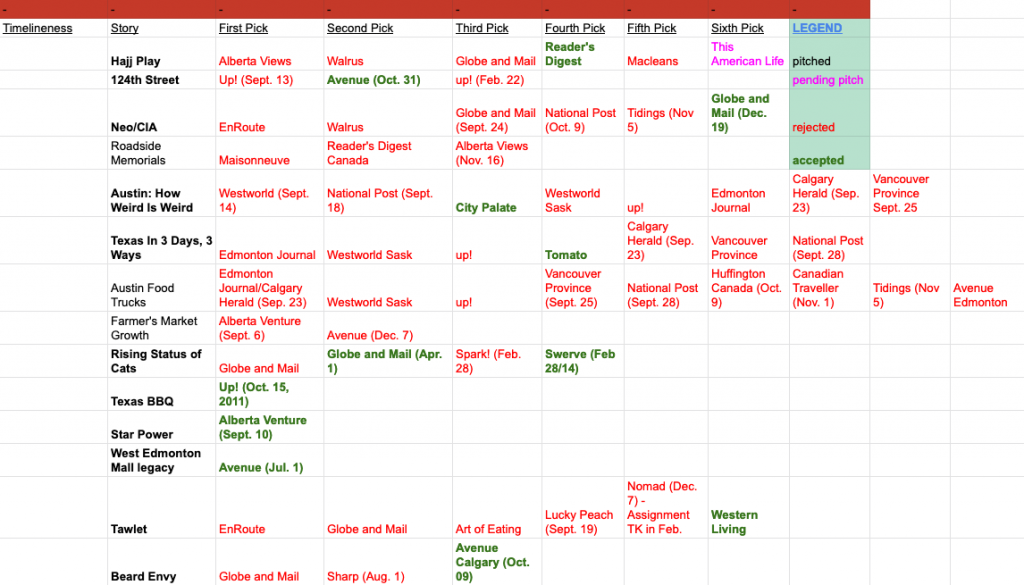In 2012, I made the leap into full-time freelance writing. It was six years in the making. I eased toward the career shift after gaining enough experience and connections as a magazine editor. Still, I worried that I might not have the self-discipline and self-motivation to sustain a freelance career. Leading up to my first official day of self-employment, I organized my story ideas in a spreadsheet that doubled as a business plan.
Looking back at it now, this spreadsheet was essential for longevity. It helped me get organized and stay organized. But it also kept me optimistic and forward looking when the inevitable rejections arrived (or didn’t).
It started as a simple list of encapsulated pitches down one column and the outlet for whom I wanted to write the story down another. I colour coded the pitches purple (not yet pitched); black (pitched, answer pending); green (pitch successful); and red (pitch rejected). Then I added another column for the next outlet in case my Plan A failed, then another in case Plan B failed, then another, and another, and soon I had my first five or six choices figured out before I even sent the pitch (for some stories, I had as many as nine!).
It looks like this:

The first thing you’ll notice is a lot of red. Bad, right?
But that’s not what you should pay attention to. Look for the greens, and you’ll notice one on 11 of the 14 rows. That’s 79% of them. In other words, I only hit a few home runs but had a wicked batting average. I owe that to the discipline, structure, and organizing enabled by my pitch bank.
After eight years, my system is still a work in progress. I recently started inputting each pitch date to help me stay on top of my follow-ups, giving editors about two-weeks to respond before moving on to the next. I sometimes included a time-peg as a reminder to myself of the most timely stories, which ultimately helped me prioritize my pitches.
My spreadsheet now has 160 ideas. Of the 115 that I sent, the vast majority were successful … eventually.
Just because your pitch was rejected once doesn’t mean it won’t find a home. It almost certainly will if you: 1. Keep trying; 2. Keep tweaking; 3. Stay realistic about your readiness for certain publications. (If The Atlantic, Time, and Washington Post rejected the story, try a smaller title willing to take chances on new names.)
Most importantly, don’t give up on a story until you’ve exhausted it or come to the realization that it was never that good anyway (hey, it happens to the best of us!). Really, how much time does it take to copy and paste that pitch for another editor and re-tune it for their readership? Fifteen minutes — an hour, tops.
To throw in the towel after one rejection, or to forget which stories you’ve pitched, to whom, and when, is basically throwing money away. You already did the work once, why would you quit before getting paid?
My system might be too robust for some; for others, not enough (my friend Fatima Syed told me she has a similar spreadsheet, only with editor names and emails). Whatever your system is, just make sure you have one. And if you’d like to steal mine and make it your own, go ahead.
Download pitch bank template here.
I included a few real stories and a few fake ones as an example. I also added a legend for the colour coding, too. I hope it helps!
If you’re looking for more help with pitching, I recorded a 2-hour tutorial called “Pitch Perfect” for Pandemic University School of Writing. You can purchase access to the class, plus all my notes and tip-sheet, for $10 CAD.
